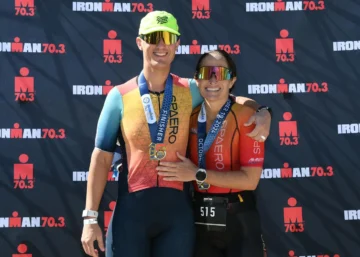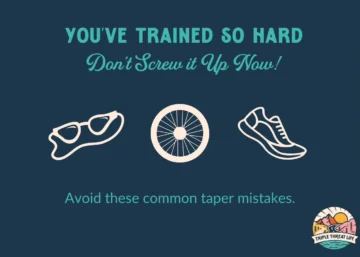
My friend Ciara posted something this week that made me think.
She and her daughter Bella are getting ready for the 70.3 Ironman World Championship in New Zealand in December. (They were the first mother-daughter team to compete at Kona, so they’re pretty awesome.)
The post was a little video recap of their 70-mile ride as they drove home to get some much needed sustenance and sleep. It wasn’t very exciting. Both ladies were tired and hungry.
Ciara said, “Behind the scenes is a little lackluster at times. Which is actually real life and real training- uneventful but necessary.”
It reminded me of this “brilliantly boring” commercial from PNC Bank.
The premise is that boring is what you want from your bank- steady and reliable.
Boring gets you where you want to go. Boring helps you achieve the things you want in life- to go on a vacation, save for college, start a business, buy a home, retire early.
I thought this was a perfect analogy for triathlon training.
Sometimes it’s not special or exciting, but consistency is what leads to brilliance in the end.
“The mundane, boring stuff can definitely wear you out. But it’s all those small details that make the difference. And that’s where the boring becomes brilliant.”- six-time Indy Car Champion Scott Dixon
As a race car driver, Dixon and his team are always looking for the extra edge, any minute advantage they can gain over the competition. That means checking and re-checking equipment, pouring over data and statistics, looking at how past training runs predict future performance.
It’s pretty boring.
Triathlon training can be the same, especially if you’re planning on doing a 70.3 or an Ironman. Here’s why.
Training plans vary widely based on the individual and coach, but you’re looking at anywhere from 4-6 months for a 70.3 and 6-12 months for an Ironman. That’s a big time commitment, especially when you look at the breakdown of the number of times you need to swim, bike, run, and do strength per week.
Hopefully, you enjoy at least one of the three sports (otherwise I’d question your decision to do a triathlon in the first place) so it’s likely you will enjoy most of your workouts. My favorite things about training include swimming in our outdoor pool in the sunshine, going on long bike rides with my friends, and doing trail runs with my husband.
But as the fatigue builds over time, you will get tired. You’re going to have to balance training with the demands of work, family time, doing laundry, cleaning the house, cooking dinner, taking care of kids, ect.
In the later stages of training, the joy might be found more in the satisfaction of completion than the actual doing. And that’s ok.
Matt and I just got home from racing on Sunday, so we haven’t had time to go to the grocery store or clean the house. I have publication deadlines to meet, and he’s seeing 18 patients a day. We had a 2,800 yard swim yesterday followed by an hour in the gym, and he was not feeling it.
Sometimes it’s just like that. Now of course you need to listen to your body, take rest days as needed, and make necessary adjustments to prevent injury, burnout, ect. But if we’re really being honest, a 70.3 doesn’t care. An Ironman doesn’t care. The distance is the distance. And if you plan on being prepared to cover that distance, you have to complete the training.
You just have to get it done. If you don’t feel fantastic while doing it, even better, because you’re probably going to reach a point during the race when you don’t feel fantastic.

In triathlon training, and life, the work you put in every day is what leads to big breakthroughs. But it takes time. Despite what some people would have you believe, there isn’t a special workout that’s going to make you swim like a salmon, or run like a pro. That’s not reality.
Instead, it’s consistent work put in on a daily basis that helps you develop the skills, technique, physical fitness, mental resilience, and capability to perform when it counts. There will be setbacks certainly, but there will also be great days. Days when you completely surprise yourself because you accomplished something you didn’t know was possible.
So do the boring things. Swim endless laps staring at the black line on the bottom of the pool. Get up early to ride on the trainer before work. Go on runs in the heat of the day. Practice transitions. Dial in your nutrition strategy and pacing plan.
Do the boring things, because one day boring will produce brilliance.
Question of the Day:
JT– “Is a swimskin worth it?”
Brittany– It depends. When thinking about triathlon gear, I try to put things in categories of “want” vs. “need.” A swimskin is a want, not a need. If you’re a capable swimmer with good technique, then sure a swimskin will make you faster in a race that’s not wetsuit legal. However, a swimskin provides no added buoyancy, only a hydrophobic coating, so it’s not going to “help” you swim any better. Also, consider the climate where you live. If you live in a hot climate, chances are a swimskin would be a better investment than if you live in a colder climate.
Upgrades can be enticing in this sport, but make sure to back up any investment with effort. For example: When I started triathlon, I didn’t buy a triathlon bike with electronic shifting right away. I rode a used road bike with clip on aerobars. It wasn’t until a year later that I upgraded to a triathlon bike. Work to be the type of athlete that’s worthy of upgrades. If you’ve done that, then buy whatever your heart (and pocketbook) can handle.


